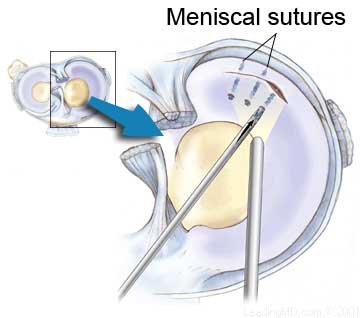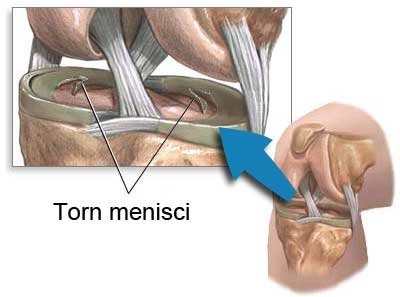The knee joint contains two rubbery C-shaped pieces of cartilage called menisci (single=meniscus). These menisci act as shock absorbers between the thigh bone (femur) and chin bone (tibia). They also help to stabilize the knee joint.
Causes of meniscal tears:
- In young adults: During vigorous sports, the meniscus may be torn while the player is squatting or twisting his knees. This may be associated with other injuries in the knee such as a tear in the cruciate ligament or an ulcer of the cartilaginous surface of the joint.
- In old patients with knee arthritis, the menisci are usually friable and prone to tears. In such patients the tear may occur with a minor trauma as while standing from a low chair or a minor twist of the knee.
Symptoms:
- The patient feels a sudden pop in his knee when the meniscus is torn.
- Pain of variable degree according to the severity of the injury.
- There is usually swelling of the knee with limited ability to fully bend or extend the knee.
- Locking of the knee can occur in cases in which a large fragment of the meniscus becomes detached from its normal position and become locked between the bones.
- Giving way and sense of instability.
The doctor can suspect the presence of a meniscal tear by examination of the knee. He may then order imaging tests :
- X-rays: this will not show the meniscal tear but may show other lesions and other causes of knee pain such as osteoarthritis.
- MRI: this is the main investigation to confirm the diagnosis and visualize the tear to determine its exact location and size. It also shows if the patient has a discoid meniscus or a meniscal cyst.
Treatment:
The type of treatment depends on several factors including: the patient’s age and level of activity, the size and location of the tear and any associated injuries.
First aid treatment:
As with most sport-related injuries, use RICE which stands for:
- Rest: stop the activities that increase the pain and in severe cases crutches may be used to help take some weight off the knee joint.
- Ice: apply ice packs for about 15 minutes several times
- Compression: applying an elastic bandage to the knee help prevent excessive swelling
- Elevation: lying down and elevating the affected limb helps decrease the amount of swelling.
Taking anti-inflammatory drugs e.g. ibuprofen may relieve the pain and swelling.
Surgical treatment:
If non-surgical treatment fails to relieve the symptoms, arthroscopic surgery may be required. Through the arthroscope the doctor have the option to do either:
- Menisectomy: which means removing the torn part of the meniscus and preserving the remaining normal meniscus.
- Meniscal repair: in young patients with simple tears in the outer most part of the meniscus, the tear may be sutured with special stitches.


